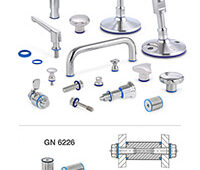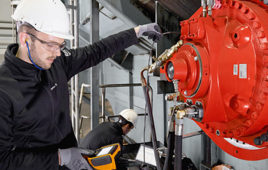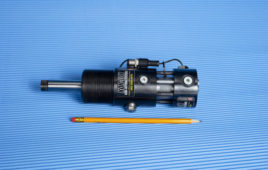By Ken Traub/Director/Bosch Rexroth Filtration Systems
Hydraulic fluids flow through filters in a spiral pattern that improves flow, increases absorption capacity, keeps filters cleaner and protects hard-working equipment from contamination.

The filter bowl design improves filter element mounting and stability and helps to ensure constant pressure distribution.
Keeping hydraulic fluids clean and free from contaminants is a constant challenge. That challenge has only increased as new types of fluids are introduced and demands are placed on high-tech fluid power systems. Greater demands for precision, positional accuracy, repeatability and durability have led to more sophisticated, specialty engineered components such as high-performance valves. Today’s industrial applications demand tighter tolerances as well. These developments have had an unwanted side effect: the more sophisticated the hydraulic component, the more damage that dirt and other contaminants can do. Designers have responded over the years by steadily increasing the sensitivity of filters, so that micron-level filtration is not uncommon today.
The science of dealing with filtration issues in actual hydraulic applications, however, has tended to remain rather low-tech—wait until the filter gets clogged, then clean or replace it. All filters eventually become saturated with contaminants and need to be replaced or serviced before reduced fluid flow compromises hydraulic performance. The question becomes when and how often should maintenance be done? Often, the first sign of a problem is a sudden drop in hydraulics efficiency, which typically results in a shutdown until the filter is replaced or cleaned. In some applications, a system of regularly scheduled maintenance is used, but this can be inefficient if the system is shut down or filters replaced when there’s no need. Filter clogging rates do not generally conform to a user’s schedule, either, so sudden drops in machine performance can’t always be avoided.
Bypass check valves, another common approach, can keep hydraulics operating longer as dirt accumulates, but there are potential drawbacks here, too. The bypass line can turn into a backflow channel if hydraulic fluid pressure drops below certain levels, allowing contaminated fluid to recirculate through the system and cause damage. The likelihood of this occurring is increased by the fact that once contaminants begin accumulating at a given spot on a filter, they attract even more contaminants at that spot, causing sudden clog forming and pressure drop.
Twist and shout
The clogging phenomenon can be avoided through a system that spreads the particles out more evenly, and directs the larger, heavier ones away from the filter while the fluid flows through. That type of system, inspired by the swirling motion of the natural force called a cyclone, is the design idea behind the 110 LE(N) “cyclone” filter series.
Here, the filter head is designed to force the incoming fluid to veer off at an angle alongside the filter instead of flowing directly through the filter element. The hydraulic fluid deflects off a protective sleeve and flows in a spiral pattern around the filter materials (mesh, fleece, etc.) as it moves down toward the filter bowl. This ensures that heavy dirt particles are transported to the outside away from the filter pores. Contamination residue is more likely to accumulate in the indentations of the filter bowl rather than in the filter itself. This residue is then simply removed from the bowl.
The design results in a filter that is not only more efficient (thanks to the hydrodynamic effects of the cyclone pattern), but is more durable as well. A pressure spring in the filter orients the filter element to the grooves in the filter bowl bottom and protects the filter element from uncontrolled movements due to flow and vibration. The filter bowl bottom’s design helps to distribute the pressure evenly and prevents overburdening of the filter in demanding applications. The useful life between maintenance can be greatly extended, compared with standard filters, because the cyclone filter takes longer to become saturated.
Of course, sooner or later, the 110 LE(N), like all filters, will eventually become saturated with contaminants and need servicing or replacement. To solve this issue, designers added an electrical early-warning indicator. A yellow traffic light comes on and sends a signal to the control. The indicator tells the maintenance personal that the element is at 75% capacity and replacement should be scheduled. At 100% capacity, a red light indicates it is time to replace the element. In addition, a spring-mounted red pin pops up automatically from the filter head when fluid pressure drop is above a certain setpoint, also indicating that the filter has reached critical operating condition. This reduces the time, effort and expense of maintenance. Because operators get advance warning (75% capacity) when the system needs attention, filter elements won’t be changed unnecessarily just because of fixed maintenance schedules.

The filter head is designed to move hydraulic media, and particles, in a spiral motion that enhances flow particles and increases absorption of particles.
In some applications, a mechanical indicator may be less than optimal because the filter may be difficult to see. That’s why there’s a second option—an electronic indicator that can be fastened on top of the mechanical indicator and provides color signaling to indicate the filter’s condition. Just like a traffic light, a green light means the filter is less than 75% saturated or go; at 75% capacity, a yellow light appears, followed later by a red light means the filter is 100% saturated.
The filter element itself adds to reliability and decreases maintenance concerns. It features six layers of asymmetrically arranged inorganic glass fiber media. The combination of filter layers achieves high efficiency and dirt holding capacity, while keeping pressure loss to a minimum. The filter material is star pleated, positioned around an internal, cylindrical support tube and wrapped in a protective sleeve made from perforated plastic film. This protects the filter against mechanical damage and ensures that the hydraulic fluid flows evenly to the entire filter area.
The cyclone filter concept can bring significant benefits to hydraulic applications: greater reliability, better machine performance, and more efficient maintenance. The filter can be cleaned without replacement via the filter bowl detents which collect larger particles at the bottom of the filter bowl, and when replacement becomes necessary, it can be accomplished before the accumulation of particles impacts performance. The installation of an electronic monitoring system is relatively simple—as is the installation of the filter itself, which protects hydraulic performance without need for a bypass check valve.
Challenge:
Prevent debris, dirt and particles from reaching sensitive high-pressure hydraulics, while avoiding clogged hydraulic filters and reducing the need for filter replacement or maintenance.
Provide hydraulic equipment operators with advance warning when a hydraulic filter begins to become saturated with particles.

Solution:
110 LE(N) hydraulic filter series with specially developed filter head that propels hydraulic media in a spiral, cyclone-like path.
New filter bowl design for filter mounting. Cyclone pattern directs dirt particles toward filter bottom, where they can be removed, and away from the filter itself.
Mechanical/electronic contamination indicator for filter monitoring and advance indication of when the filter is becoming saturated.
Benefits:
Increased reliability and uptime for hydraulic equipment.
Better repeatability and accuracy in positioning for hydraulics.
Improved filter life and reduced maintenance.
Electronic indicator can be added during machine operation without opening up hydraulic elements.
No need for bypass check valve; simpler and smaller installation.
Bosch Rexroth Corp.
www.boschrexroth.com
::Design World::
Filed Under: Hydraulic equipment + components, FLUID POWER






Tell Us What You Think!